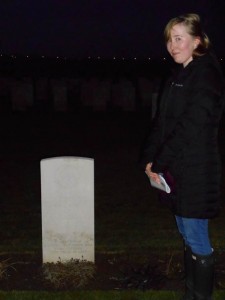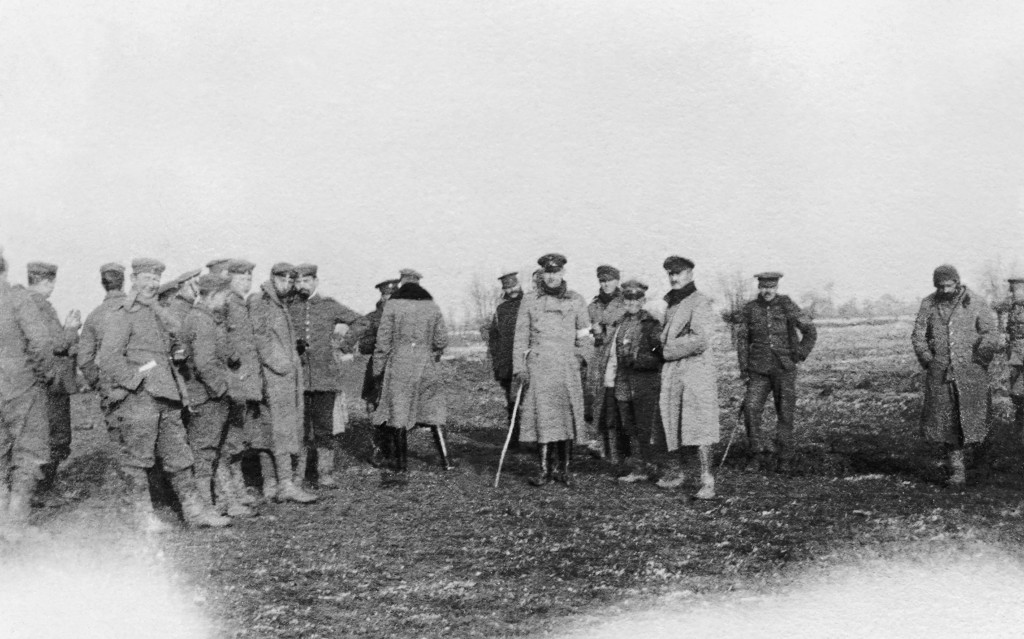Gateways’ Dr Emma Hanna looks back on the first months of the First World War centenary.
The Christmas break has given me time and space to reflect on the centenary so far. The run-up to Christmas is always a frenetic time but this year, with a lot of commemorations of the ‘Christmas Truce’ and my annual 3-day student field trip to Belgium and France, it was particularly busy. Saying that, for me the year 2014 will go down as one of the most productive years of my professional life. Never before have so many conferences, symposia and public events taken place. Edited collections, exhibitions, you name it, we’re doing it. The centenary so far has been a whirlwind of activity.
The year started on a high with the news that our bid at Gateways had been successful, and as many of us were already working on FWW-related projects we all hit the ground running. In addition to my own research and teaching, this time last year I was working with the British Council on their ‘Football Remembers’ resource and that was a very intense experience: not only did I get to research one of the best myths of 1914-1918 but that project also taught me all there is to know about copyright law. As part of the resource the British Council set up a competition for 8-14 year old pupils to design a memorial to the Christmas Truce. To see the finished design by a ten year old boy from Newcastle unveiled by the Duke of Cambridge at the National Memorial Arboretum on 12th December was really quite something. While I didn’t have anything to do with that memorial I still feel a sense of satisfaction of a project completed and that the resource was doing its job well. I couldn’t be at the unveiling of the memorial in Staffordshire because I was at the Gateways Christmas Truce Symposium at the University of Kent – a really enjoyable event attended by over 50 members of the public. Other memorials have been unveiled. On 8th December I was at Ploegsteert with 25 undergraduate students and our coach got stuck down a small road at Prowse Point cemetery because the lane was full of construction equipment as they were installing a Belgian memorial to the Christmas Truce – featuring, of course, a football. However, the spirit of peace and goodwill did not quite extend to the beleaguered Belgian police officer who helped our coach reverse up 1km of narrow muddy track.
It is always a moving experience going back to the old front line. Even now, as my own tally of visits to the former battlefields is well into double figures, there is always something you missed or didn’t do before. Taking groups of students, and for many it can be their first visit, it’s a cliché but it does help me see the war and the landscape through fresh pairs of eyes. Arranged via the new visitors’ centre at Ploegsteert, a new experience this year was a two hour tour of the area with Claude, a local guide who boarded our coach and showed us the various sites – including of course lots of references to Churchill and Hitler who fought in that area at various times, and the location of two as yet unexploded mines near Messines. We also had two students who recently discovered they each had a great-grandfather buried on the Western Front. Both paid their respects to their predecessors, and both were the first members of their families to visit the graves. I find that particularly moving: how many of those men have gone unvisited for nearly 100 years? During the centenary there will be more visitors to the battlefields than ever before, and in Peronne I did detect centenary fatigue. While the staff at the Historial could not have been more helpful (as always), the locals at various establishments in Peronne appeared weary of foreign (English) visitors. Perhaps they are tired of battlefield tourists, and even the value of 27 croque-monsieurs and a round of Leffe will not alleviate the burden of inhabiting the former battlefields. Even Paul Fussell identified a certain mood around the battlefields in 1975.

Nick Hudson at the graveside of his Great-Grandfather, Private Sidney James Best,20th Battalion London Regiment; died 1st October 1916, buried at Warlencourt British Cemetery, France.

Megan Kelleher at the graveside of her Great-Grandfather, Private C. Bonnard, Royal Warwickshire Regiment, died 30th May 1915, buried at La Plus Douve Cemetery, Belgium.
The war has become very local to me this year. I will always remember the evening of 4th August 2014; after an academic conference in London during the day, I was invited to give a short talk at the start of a ‘Lights Out’ event in Harrietsham parish church in Kent, near to where I live. The organisers had done a great deal of research into the parish during the war, and a cast of 12 villagers ‘performed’ the characters and words of local people from August 1914. It was tasteful and respectful, and it gave me goosebumps to sit in the church where so many of these men worshipped, were baptised and/or married. I have never seen a church so full of people, it was packed. I was only there to give a 10 minute explanation of how the war started and to give a general overview, something I do all the time for students, but it was one of the most moving experiences of my professional life. It felt incredibly emotional as the church bell rang for every man lost, a bell they themselves would have heard and remembered. I also did some work and a talk on the Great Chart Sailors’ and Soldiers’ Fund, again a village very close to where I live, and reading through so many servicemen’s letters I feel I got to know many of them rather well. When I gave a talk on the collection at the Kent History Centre in Maidstone two of the audience were direct descendants of some of the men, and I was very relieved that they enjoyed the talk and thought that I had done their relatives justice. At times like that this feels very much more than just a job.
Overall the FWW has become very present in our everyday lives. The BBC’s centenary coverage on TV and radio is going to be longer than the war itself, and my Sky+ box at home is groaning under the weight of so many recorded programmes about 1914-1918. The war has also come to the forefront of political debates. John Major invoked the memory of both World Wars just before the Scottish Referendum in September, and the poppies at the Tower ignited a debate about national identity and the ways in which Britain should remember 1914-1918. A left-wing art critic writing in The Guardian slated the memorial as ‘a fake, inward-looking Ukip-type memorial’ [sic.]. He criticized the poppies’ ‘fake nobility’ and asked why were only commemorating British dead and not mourning German, French or Russian casualties. He suggested that a far more fitting memorial would be for the moat of the Tower ‘be filled with barbed wire and bones.’ A Daily Mail journalist was astonished that ‘anyone could politicize this magnificent project, any more than someone might quibble with the Cenotaph.’
Speaking of UKIP, on 9th December at the Menin Gate in Ypres, my students and I saw Nigel Farage at the Last Post ceremony. He didn’t appear to be there in any official capacity – he and his entourage were doing the same as us, paying their respects. However, I was greatly upset by a speaker who gave a short biography of a British officer who ended by saying his death during the conflict was part of the ‘routine wastage’ of the war. I looked at the endless names inscribed on the memorial and I felt both angry and sad that the death of a human being could be described like that. But that is the task ahead for FWW historians during the centenary – not to condone, excuse, or glorify the war and its horrific number of casualties – but to help others as best we can to understand a difficult war fought in difficult circumstances, and above all to ensure that the memory of 1914-1918 is worthy and respectful of those who still lie on the old front line.
All photos courtesy of Dr Emma Hanna, Gateways to the First World War



